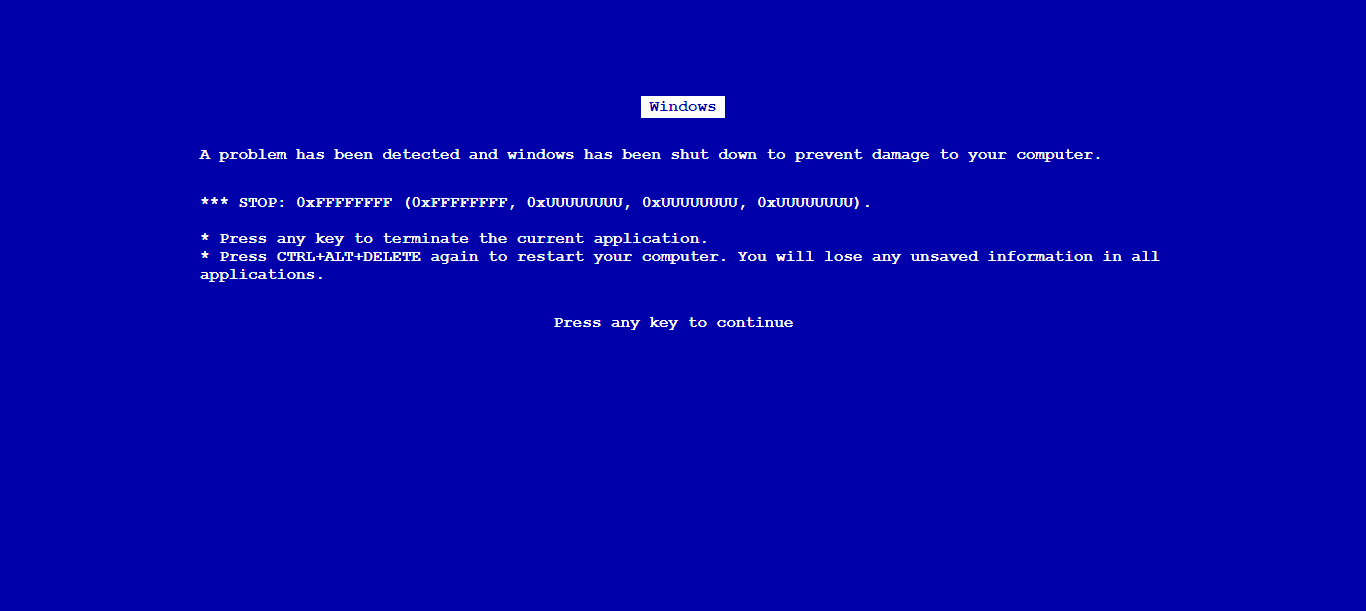Unraveling The Mystery Of The Fake Blue Screen
The digital world is filled with wonders and surprises, but it also has its share of tricks and illusions. One such phenomenon that has captivated tech enthusiasts and pranksters alike is the fake blue screen. A fake blue screen, often mimicking the infamous Blue Screen of Death (BSOD), can be both a source of amusement and a tool for deception. Understanding the nature of this digital trickery is essential for anyone navigating the realm of technology, whether for fun or serious purposes.
In recent years, the fake blue screen has become a popular tool for pranksters who want to create a moment of panic or confusion among their friends or colleagues. The graphics and messages displayed resemble those of a real system error, leading the unsuspecting user to believe their computer has crashed. However, beneath this facade lies a harmless prank that, when used responsibly, can provide a good laugh. Yet, the implications of such tricks can vary, and it's essential to recognize when humor crosses the line into potentially harmful territory.
As technology continues to evolve, so too do the methods and tools used to create these fake blue screens. From simple software applications to more sophisticated techniques involving coding, the creation of a fake blue screen has never been easier. In this article, we will delve deeper into the world of fake blue screens, exploring their origins, how they work, and the potential consequences of their use. By understanding this phenomenon, we can better appreciate the creativity behind it while remaining mindful of the potential for misuse.
What is a Fake Blue Screen?
A fake blue screen is a simulated version of the Blue Screen of Death (BSOD), a critical error screen displayed by the Windows operating system when it encounters a fatal system error. This imitation can be created using various software applications or even through coding, designed to trick users into believing their computer has crashed.
How Does a Fake Blue Screen Work?
Fake blue screens function by overlaying a screen that mimics the appearance of a genuine BSOD. This overlay may display error messages, technical jargon, and other elements typically associated with a real crash. Often, users are left confused and anxious, believing their computer is malfunctioning. However, the reality is that the system is still operational; the screen is merely a visual prank.
Why Do People Create Fake Blue Screens?
There are several reasons people create fake blue screens, including:
- To play harmless pranks on friends or colleagues.
- As a means of stress relief or entertainment.
- To test the reactions of others in a controlled environment.
- To create educational tools that illustrate the concept of system errors.
Are Fake Blue Screens Harmless?
While many see fake blue screens as harmless pranks, they can have unintended consequences. For instance, the sudden appearance of a fake BSOD can lead to panic or anxiety, especially for individuals unfamiliar with technology.
What Are the Potential Risks of Using Fake Blue Screens?
Using fake blue screens comes with certain risks, including:
- Misleading individuals, causing unnecessary concern about their computer's health.
- Creating a negative experience in professional environments.
- Potentially damaging trust between users and technology.
How Can One Create a Fake Blue Screen?
Creating a fake blue screen can be accomplished through various methods, including:
- Using dedicated software designed specifically for generating fake blue screens.
- Employing coding skills to develop a custom fake BSOD.
- Downloading pre-made images or videos that simulate the blue screen effect.
How to Respond to a Fake Blue Screen?
If you encounter a fake blue screen, it's essential to remain calm and assess the situation. Here are some steps to take:
- Check if your computer is responsive; try moving the mouse or pressing keys.
- If the screen is not real, simply close the program or restart your computer.
- Inform the individual responsible for the prank if it's a friend, and discuss how it impacted you.
Can Fake Blue Screens Be Used for Educational Purposes?
Yes, fake blue screens can serve as educational tools to illustrate the concept of system failures and errors. They can be used in workshops, classrooms, or training sessions to help individuals understand how to respond to real BSOD scenarios, enhancing their technical knowledge.
Conclusion: The Dual Nature of Fake Blue Screens
In conclusion, the fake blue screen is a fascinating aspect of digital culture that can evoke both laughter and concern. While it can be a fun and harmless prank, it also carries the potential for misunderstanding and anxiety. By understanding the motives behind fake blue screens, their impact, and how to respond, we can appreciate this digital phenomenon while navigating the fine line between humor and responsibility.
Unpacking The Humor: Exploring Hilarious Racist Jokes
Exploring The Versatile Career Of Veronica Cartwright
Unlocking The World Of Entertainment: A Deep Dive Into Katmoviehd Download


